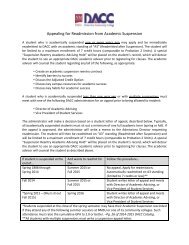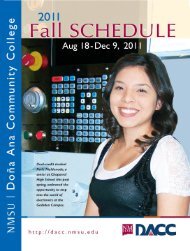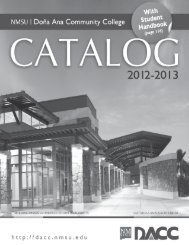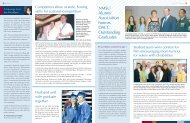online - Dona Ana Community College - New Mexico State University
online - Dona Ana Community College - New Mexico State University
online - Dona Ana Community College - New Mexico State University
Create successful ePaper yourself
Turn your PDF publications into a flip-book with our unique Google optimized e-Paper software.
munity leaders to plan, implement, and evaluate community health<br />
education interventions such as smoking cessation, chronic and infectious<br />
disease awareness campaigns, vaccination programs, and<br />
family planning and prenatal care initiatives. This program is ideal<br />
for those who like to work with the public, yet who also like to take<br />
the broader view of how to promote the health of communities and<br />
groups of citizens.<br />
The associate degree program fully articulates with the bachelor<br />
of community health degree program offered at the main NMSU<br />
campus in the Department of Health Science, which also offers<br />
the master of public health in community health education at the<br />
graduate level. The courses in this associate of applied science in<br />
public health curriculum at DACC will meet the majority of NMSU’s<br />
general education degree requirements and are designed to give students<br />
a full overview of what public health and community health<br />
education practice is all about. There are no special admissions criteria<br />
for this program, but prospective majors are advised to arrange<br />
an initial degree advising session with the faculty of DACC’s Health<br />
Occupations program in the Division of Health and Public Services.<br />
The program director will also be able to advise students regarding<br />
choices for elective courses.<br />
Associate Degree (66 credits)<br />
NOTE: Courses appearing in italics may be applied toward a bachelor’s<br />
degree at NMSU.<br />
Technical Requirements<br />
19 credits<br />
NOTE: The CHSS and HL S courses listed here may be<br />
applied toward the bachelor’s degree program in <strong>Community</strong><br />
Health at NMSU.<br />
CHSS 101 Overview of Health and <strong>Community</strong> Services 3<br />
CHSS 216 Ethical and Research Issues in<br />
Human and <strong>Community</strong> Services 3<br />
CHSS 299 Service Learning Experience in<br />
Human and <strong>Community</strong> Services 3<br />
HL S 100 Overview to <strong>Community</strong> Health Education 1<br />
HL S 150 Personal Health and Wellness 3<br />
HL S 275 Foundations of <strong>Community</strong> Health Education 3<br />
HL S 295 Foundations of Public Health, 3<br />
Epidemiology and Biostatistics<br />
Radiologic Technology<br />
Associate Degree: Radiologic Technology<br />
527-7581<br />
OR<br />
OR<br />
Core Requirements<br />
30 credits<br />
OECS 105 Intro. to Microcomputer Tech. 3<br />
C S 110G Computer Literacy<br />
BCIS 110G Intro. to Computerized Information Systems<br />
COMM 253G Public Speaking<br />
OR COMM 265G Prin. of Human Comm. 3<br />
ENGL 111G Rhetoric and Composition 4<br />
ENGL 218G Technical and Scientific Communication 3<br />
Laboratory science courses selected from the following list 8<br />
ASTR 105G OR ASTR 110G,<br />
BIOL 101G+L OR BIOL 111G+L,<br />
CHEM 110G OR CHEM 111,<br />
GEOL 111G OR GEOL 212,<br />
PHYS 110G OR PHYS 211+L<br />
MATH 210G Mathematics Appreciation 3<br />
PSY 201G Introduction to Psychology 3<br />
SOC 101G Introductory Sociology 3<br />
Related Requirements<br />
17 credits<br />
One history course from the following list: 3<br />
HIST 101G, 102G, 201G, 202G, 211G,<br />
212G, 221G<br />
One course from the following list: 3<br />
ART 101G, ART 110G, ENGL 244G,<br />
MUS 101G, MUS 201G, THTR 101G<br />
Electives from any of the following categories 11<br />
• “OEHO” courses<br />
• 300- or 400-level courses offered by the NMSU Health<br />
Sciences Department<br />
• NMSU general education courses from the “Viewing a<br />
Wider World” list<br />
Radiologic Technologists are an important part of the medical team.<br />
They produce medical images (x-rays), carry out diagnostic procedures,<br />
determine safe radiation exposure limits, and collect technical<br />
data necessary to assess client (patient) status. Job prospects in<br />
the Las Cruces/El Paso area are occasionally limited, but nationwide<br />
there is faster-than-average job growth with many opportunities for<br />
persons seeking entry-level positions.<br />
Students in the Radiologic Technology program receive training<br />
both in the classroom and in clinical settings, where they work<br />
alongside nurses, physicians, and other health-care professionals.<br />
In the classroom, students learn about the anatomy and function of<br />
the human body, radiographic physics and equipment, and radiographic<br />
procedures. Students acquire skills in radiation protection<br />
for the patient and for the health professional. Laboratory activities<br />
teach the proper positioning of an injured or ill patient. Clinical<br />
work offers students training in diagnostic radiology and introduces<br />
the student to various other imaging modalities. The clinical work<br />
is offered in Las Cruces, Alamogordo, Artesia, Carlsbad, Deming,<br />
Ruidoso, Silver City, and El Paso.<br />
Graduates of the program are eligible to take (and must pass) the<br />
American Registry of Radiologic Technologists (ARRT) national certification<br />
exam in order to obtain employment in this field. It should<br />
be noted that felony or misdemeanor convictions may make a student<br />
ineligible to take the ARRT exam. Many states also require a<br />
license to practice as a radiographer in that state. Continuing education<br />
is required with both the ARRT and state licenses to retain<br />
current certification status.<br />
The DACC Radiologic Technology program is fully accredited by<br />
the Joint Review Committee on Education in Radiologic Technology<br />
(JRCERT).<br />
Special Admissions Criteria<br />
Radiologic Technology is a limited-entry program. The following<br />
items are among the criteria considered in the selection of program<br />
applicants:<br />
2 0 0 7 - 2 0 0 8 C A TA L O G<br />
59

















